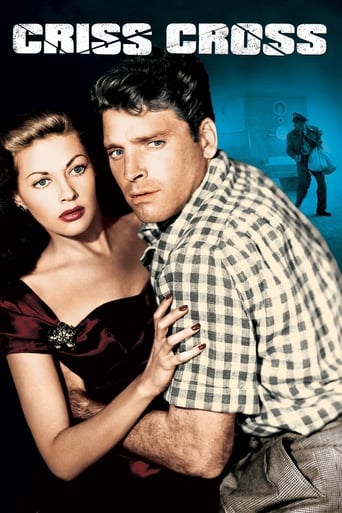drjgardner
To a purist like me "Cross Cross" is not really "film noir" because it lacks some critical elements. The protagonist (Burt Lancaster, just off "The Killers") isn't really seduced into his ill-fated venture by a femme fatale. It may look that way, but in reality the plan to rob the armored car comes from Steve (Burt), not from Anna (Yvonne de Carlo), and not even at her instigation. And Anna is not really a femme fatale who double crosses our hero. In fact she stays wonderfully true to him until she must chose between his life and hers. In most film noir the femme fatale is not merely working for herself but usually with the antagonist (Dan Duryea). In this film she is double crossing Duryea, not Lancaster. There are many noir elements in the film. The urban setting (really nice to see downtown LA in the late 40s), the motley crew of crims, and the off-beat photography are all tried and true noir elements along with the downbeat ending. But many elements are not present, as indicated above, along with the unrelenting rain and lots of night scenes.Putting aside the film noir bonafides, there are some real big plot holes in the film, all of which you will discover for yourself.It's an OK film. You get to see an uncredited Tony Curtis dancing with de Carlo, and trolley cars operating in downtown LA. But don't expect to see your classic film noir. Best case, it is noirish. In reality it is more about the dangers of obsessive love, which is one of the themes in film noir, but usually done better.BTW – if you're a fan of Robert Siodmak this isn't one of his better films – "The Killers" (1946) and "Spiral Staircase" (1945) are my favorites, and for a change of pace his teaming again with Lancaster for "The Crimson Pirate"(1952)
evanston_dad
"Criss Cross" takes a while to get going, but once it does, boy does it.Burt Lancaster is intense and brooding as a man who returns to his hometown and the ex-wife (Yvonne De Carlo) he can't get over. She's fallen in with a crime boss (Dan Duryea), and he concocts a scheme to get her free and run away with her. This being a film noir, I wasn't all that surprised by the scheme going awry, but I was surprised at just how badly it does so. This is one bleak movie with one very bleak ending, one I was not expecting at all.The three principles are terrific, not surprisingly. This is actually the only role I've ever seen De Carlo in outside of Lily Munster, and I couldn't take my eyes off of her. There's something endlessly fascinating about her.Grade: A
jarrodmcdonald-1
A few things I love about CRISS CROSS-- character actor Percy Helton as Frank the bartender; the sweet relationship between Richard Long and Meg Randall (who were paired in several Universal films); and the on-location filming in Bunker Hill and Union Station. It also looks like the robbery scene was filmed in Long Beach. So there is a lot of historical footage in this picture.But while these pluses make a strong case that CRISS CROSS is a film noir classic, there are some things about the picture that do not work for me.First, I think the ending is a bit overrated. It's effective. But Duryea is not doing anything different here than he's done with his other villain roles before or after. It's one of those everyone-must-die endings, and all he has to do after the fatal bullets are fired is to turn around and look into the headlights. Sirens blare in the background. Camera moves in and pictures fades out. One sequence, however, that does not seem clichéd is the robbery. But while it does contain a lot of action, it's staged in an uninspiring way (corny theatrics, with way too-obvious fake jabs and punches). A bright haze engulfs them from the explosion, but the director does not take advantage of the visual possibilities here. I can almost imagine what Orson Welles would have done; he would have had running shadows cutting through the bright cloud. And he would have done something to illuminate Lancaster's face in this sequence. Or at least with his hand holding the gun. His flesh is too pale and it blends in with the bright cloud of smoke to the point that we can barely see him. Overall, this film is a hodgepodge of ideas from 30s gangster pictures. It steals heavily from THE PUBLIC ENEMY-- the entire last sequence, where he gets kidnapped from the hospital is ripped off from PUBLIC ENEMY. Even the ending, where he dies is copied. The only new angle is that the girl dies alongside him.
b-kelly13
I had never seen a film from the film noir era prior to this film. I really enjoyed the story line of this film. It was interesting to see the male and female roles reversed. Normally we see the women in distress, and the man coming to her rescue. This film was the complete opposite. Steve, played by Burt Lancaster, was a man blinded by the love he had for his ex wife Anna, played by Yvonne DeCarlo. I enjoyed seeing a woman in charge.By Steve getting back involved with his ex wife, he was dragged into a secret underground world that she was now a part of. She was now involved with a man named Slim, who is nothing but trouble. Slim is involved with L.A.s mafia scene, something in which Steve did not expect to get dragged into.If you enjoy melodramas with some action, then this is a good film for you. I would enjoy to watch it again.




